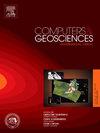Non-linear non-parametric geostatistical rock-physics inversion of elastic attributes for petrophysical properties using direct multivariate simulation
IF 4.2
2区 地球科学
Q1 COMPUTER SCIENCE, INTERDISCIPLINARY APPLICATIONS
引用次数: 0
Abstract
The estimation of subsurface petrophysical properties plays an essential role in the reservoir characterization and forecasting process. In this work, we present a novel algorithm for geostatistical rock-physics inversion of elastic properties that assumes a non-linear forward model and a non-parametric multivariate joint distribution. The inversion method is based on the numerical solution for data conditioning of the joint probability distribution and it combines statistical rock-physics models and stepwise conditional transformations applied to non-parametric geostatistical simulations. Specifically, we apply a data conditioning approach of Direct Multivariate Simulation to obtain the petrophysical properties conditioned to the measured elastic properties. The approach can be applied to estimate median models or to simulate multiple geostatistical realizations conditioned on direct measurements. We validate the approach through two applications: a 1D study using real well logs for the estimation of petrophysical volumetric fractions using a 6-variate joint distribution and a synthetic time-lapse seismic study for the estimation of porosity and fluid changes using a 7-variate joint distribution. We discuss the computational advantages of the proposed implementation in terms of computational time and RAM usage. The efficient implementation makes this method applicable to high-dimensional problems. The algorithm effectively preserves the non-linear and heteroscedastic relationships among variables, providing accurate estimations of petrophysical properties while maintaining spatial correlations and incorporating hard data conditioning.
直接多元模拟岩石物理性质的非线性非参数地球统计岩石物理反演
地下岩石物性评价在储层表征和预测过程中起着至关重要的作用。在这项工作中,我们提出了一种新的地球统计岩石物理弹性属性反演算法,该算法假设非线性正演模型和非参数多元联合分布。该反演方法以联合概率分布数据条件的数值解为基础,将统计岩石物理模型与应用于非参数地统计模拟的逐步条件变换相结合。具体而言,我们采用直接多元模拟的数据调节方法来获得受测量弹性性质约束的岩石物理性质。该方法可用于估计中位数模型或模拟以直接测量为条件的多种地质统计实现。我们通过两个应用验证了该方法:使用6变量联合分布使用真实测井进行1D研究,用于估计岩石物理体积分数;使用7变量联合分布进行合成时移地震研究,用于估计孔隙度和流体变化。我们在计算时间和RAM使用方面讨论了所提出的实现的计算优势。该方法的高效实现使其适用于高维问题。该算法有效地保留了变量之间的非线性和异方差关系,在保持空间相关性和结合硬数据调节的同时,提供了准确的岩石物理性质估计。
本文章由计算机程序翻译,如有差异,请以英文原文为准。
求助全文
约1分钟内获得全文
求助全文
来源期刊

Computers & Geosciences
地学-地球科学综合
CiteScore
9.30
自引率
6.80%
发文量
164
审稿时长
3.4 months
期刊介绍:
Computers & Geosciences publishes high impact, original research at the interface between Computer Sciences and Geosciences. Publications should apply modern computer science paradigms, whether computational or informatics-based, to address problems in the geosciences.
 求助内容:
求助内容: 应助结果提醒方式:
应助结果提醒方式:


